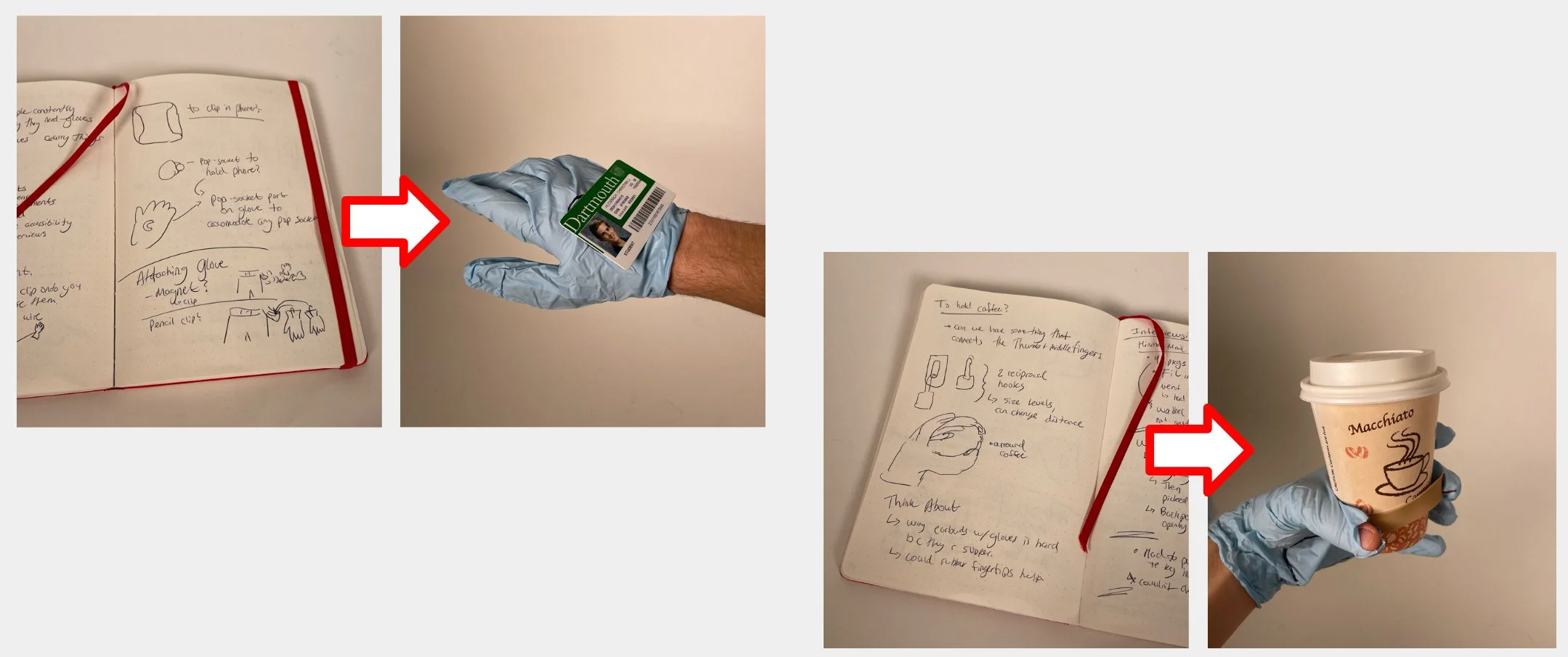Improving Glove Usability
Problem
Many students at Dartmouth find using gloves an added hassle when carrying food, drinks, or personal items, causing many students to choose discomfort in colder months to save time.
Solution
We redesigned winter gloves to include built-in features that allow students to carry around their essentials throughout their day without sacrificing functionality or warmth.
Takeaway
As prototyping lead, I guided design iterations and led the development of works-like and looks-like prototypes, enabling my team and me to refine our product quickly and effectively.
Problem
This project took place during a course called Introduction to Design Thinking (ENGS 12). The goal of this project was to spend about 10 days start to finish on a design challenge geared at helping students with the cold winter weather. My team spent about 2 days need finding, where we spent time at popular spots on campus and observed students going about their daily lives. From these observations, we identified that many students would walk around with their hands full of personal items from water bottles to hats to coffee cups. We decided to interview a few students about this, and found that holding everything was just the easiest and fastest way for students to move around while inside. A key challenge we identified from student testimonials was that during the winter, students often didn’t spend the time to pack everything back up in their backpacks, and would often walk around outside with their hands full. Students also reported that putting on gloves limited their mobility, making it much harder for them to hold all of their stuff, so most students opted to feel discomfort by not wearing their gloves. With these insights, my team and I set out to ideate potential solutions, quickly deciding on improving a glove. Because students wanted more mobility with their gloves, we had to prioritize which improvements to include so as to not over-engineer our solution. We iterated several add-ons, focused on accounting for the main categories of things students reported wanting to carry around with them. Among those categories included student IDs, dorm keys, coffee cups, and of course iPhones. Honorable mentions included ways to carry water bottles, earbuds, and plates of food.
Solution
Left Glove
Right Glove
After designing 2 different prototypes (1 looks like, 1 works like), we created our final product, Gantaport (a mash up of two French words, ‘gant’ meaninh glove and ‘port’ meaning wear). The left glove features a cup-holder on the inside, pouch for small items on the outside, and an electric-sensitive finger patch to let users use their phones with the glove still on. The right glove has a hook on the inside to hold phones by hooking around a pop-socket, an ID sleeve on the outside, and an electric finger patch, this time on the thumb. These gloves are designed for right-handed users, and the electric finger patches are the most-used fingers for right handed users on their phones.
Looks-Like
In developing our final product, we iterated 2 prototypes, a looks-like and a works-like. The first prototype we built was a looks-like model using latex gloves. This looks-like model served to get a sense for how much usable space we had on the model of a standard glove, helping us realize that we would need to be selective about which features to add due to limited available space. We then proposed this model to several peers to get feedback on our concept, and learned that the ID placement was well liked, but the coffee holder mechanism seemed awkward and prone to spilling. We also identified that using ones phone is an important function, and most cold-weather gloves are too insulated to allow for that.
Works-Like
We then developed our works-like prototype, a works-like model using wool-nylon gloves as our base. The gloves were chosen for their electronic-interfacing finger tips, allowing a user to use their phone without removing the glove. We then sewed a pouch for an ID and a strap to hold coffee and tested out the product for ourselves. We found the coffee holder again to be awkward and prone to spilling, but the electronic fingers and the ID sleeve to work as intended. We also decided that there was enough room to add more functions to the gloves and worked more into the final design.
Takeaway
My role in this project was prototyping lead. I had two other team members, one responsible for coordinating user testing and research and the second as our team leader responsible for time management project work flow and deliverables. My work focused on leading design iterations in group brainstorming sessions, then applying technical prototyping skills to render our ideas. As this project was only 10 weeks long, I learned a lot about rapid research and iteration. This was also my first experience working with concepts like ‘works-like’ and ‘looks-like’ prototypes, which enabled myself and my team to quickly gain insightful feedback on designing the function of the concept and the appearance of the product. This was such a fast-paced project, and we really didn’t have enough time to conduct sufficient user research to inform our decision making, so much of our design process was informed by our own personal experience, shaping our user specifications and our final design. To that end however, I got to keep our final product after the project, and I enjoyed using them myself quite a bit, as I found they worked really well for our intended usage.






